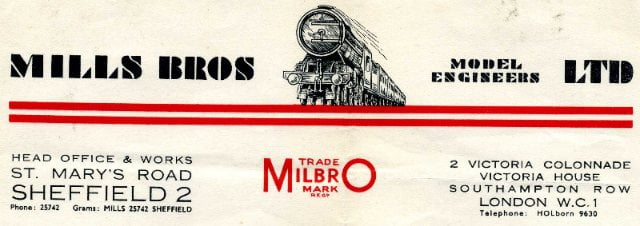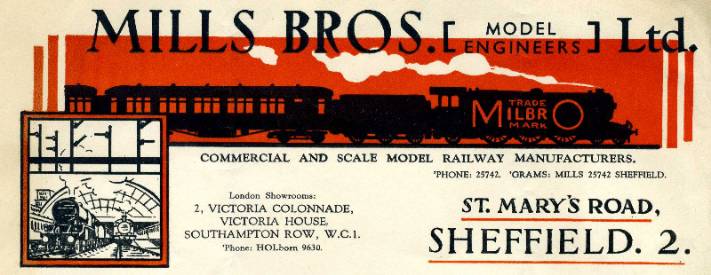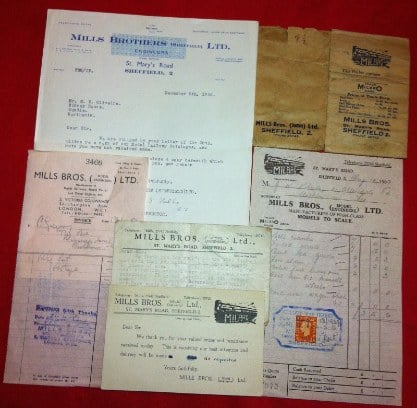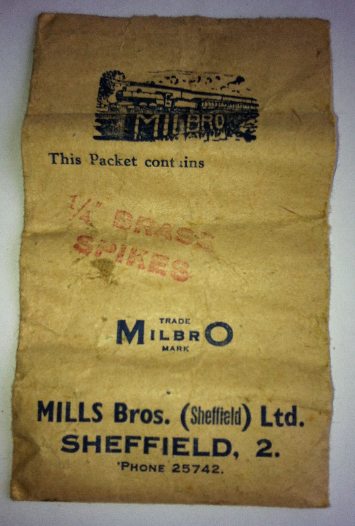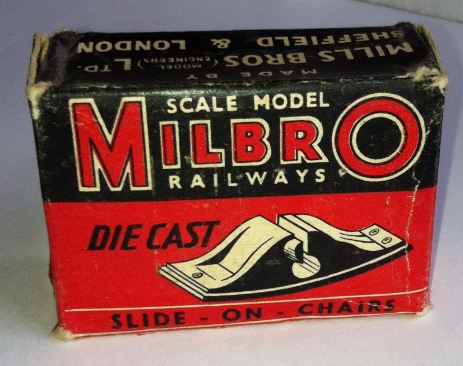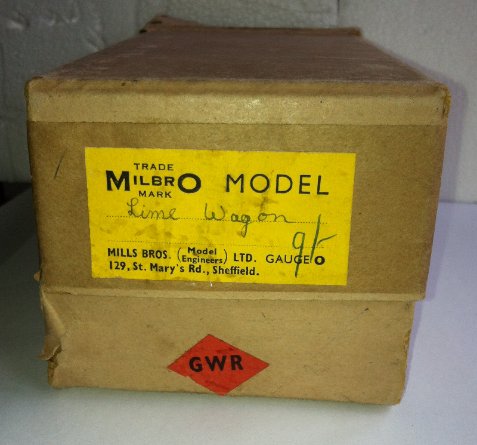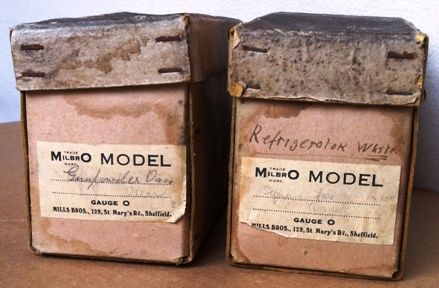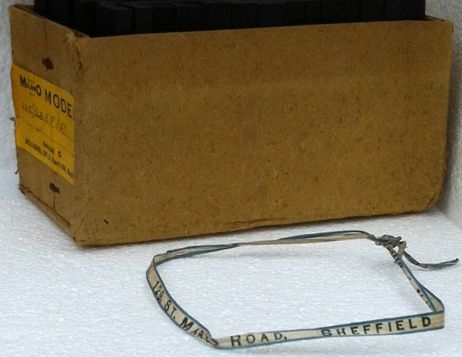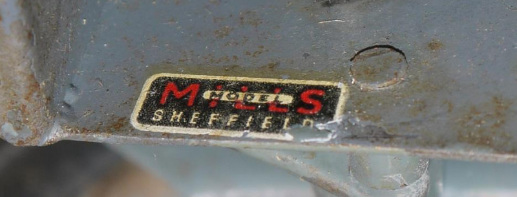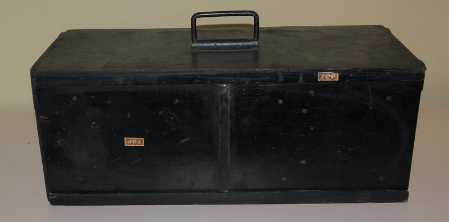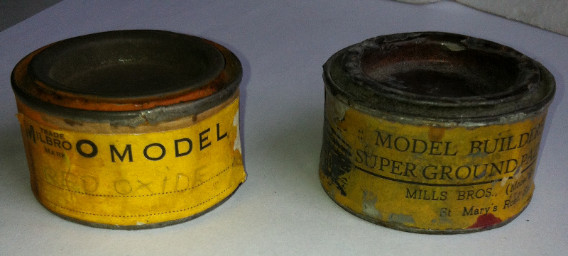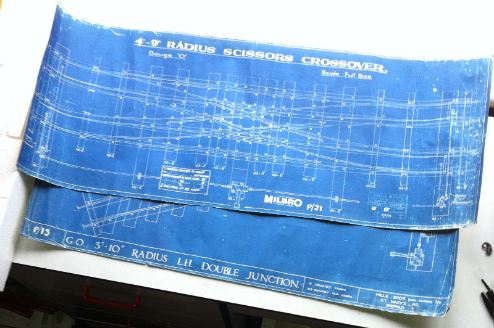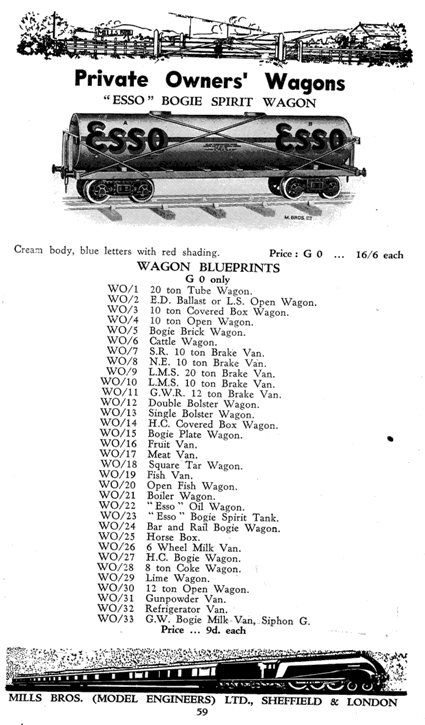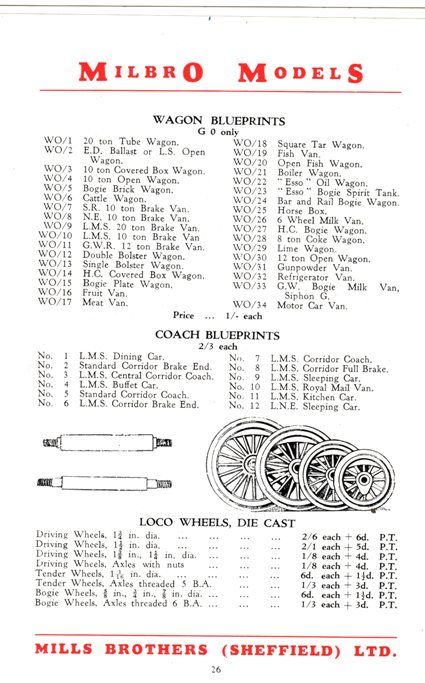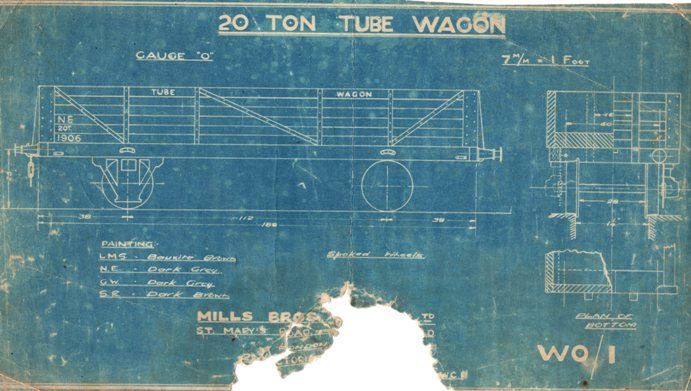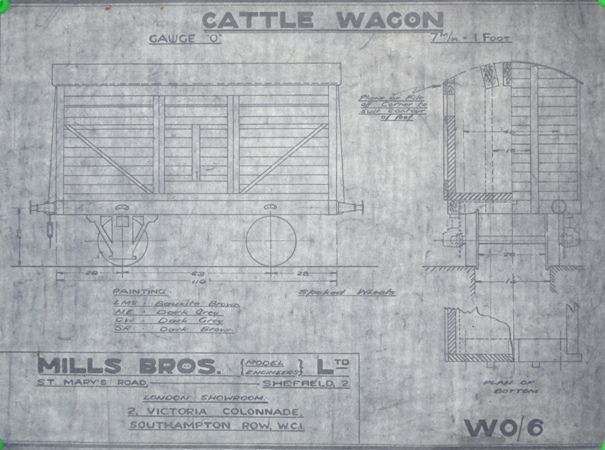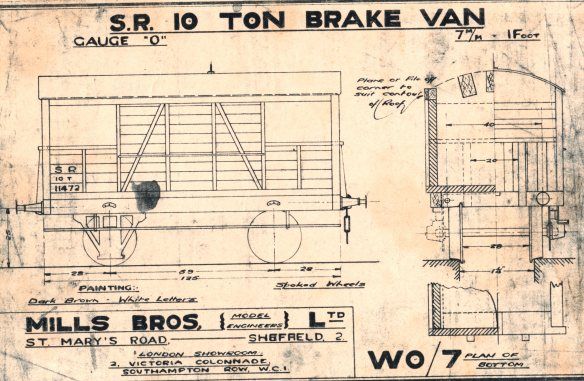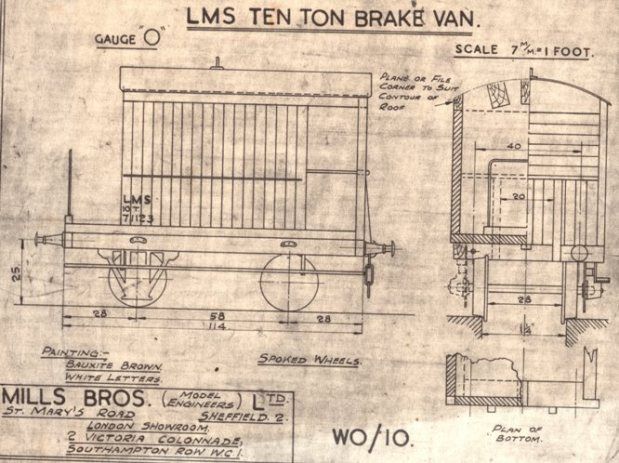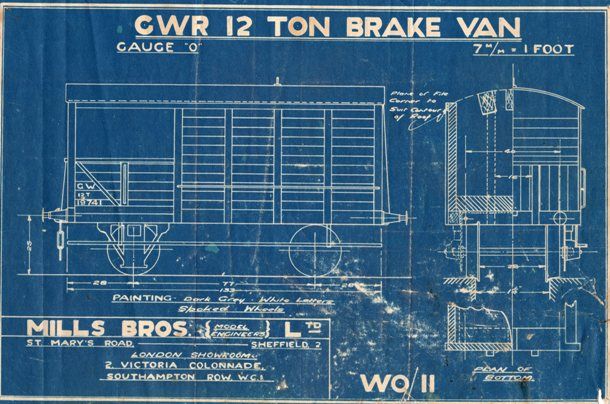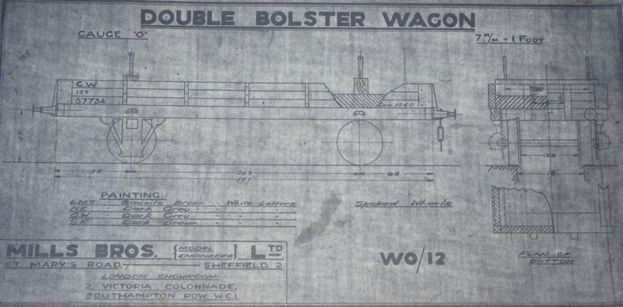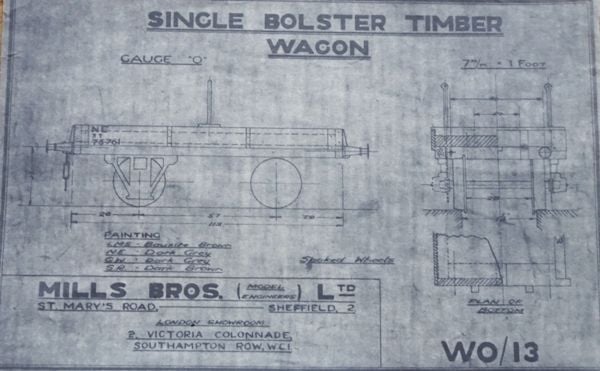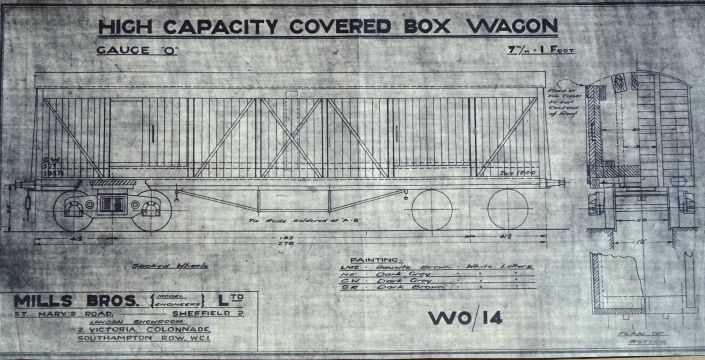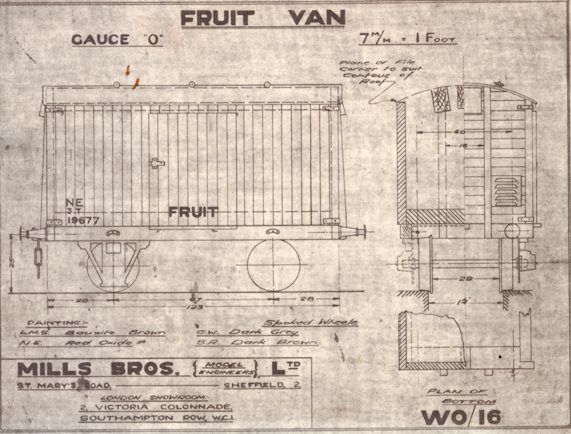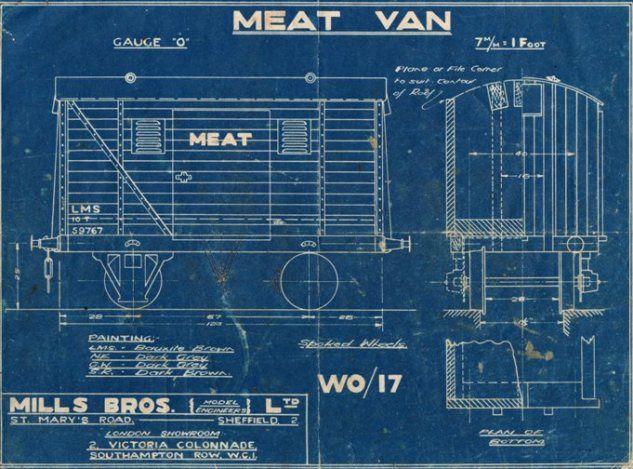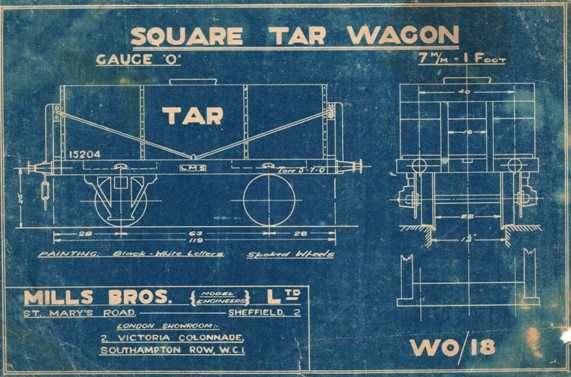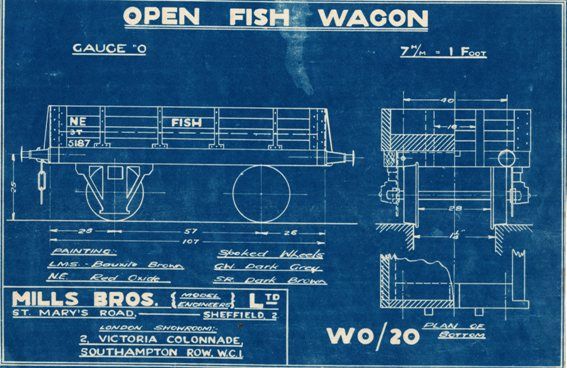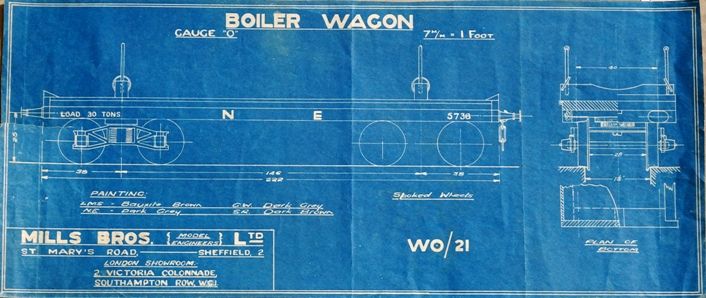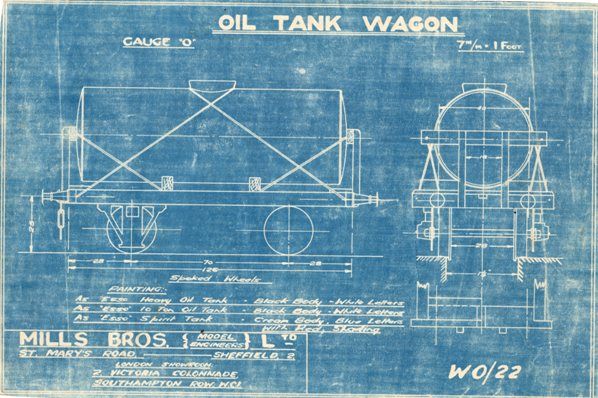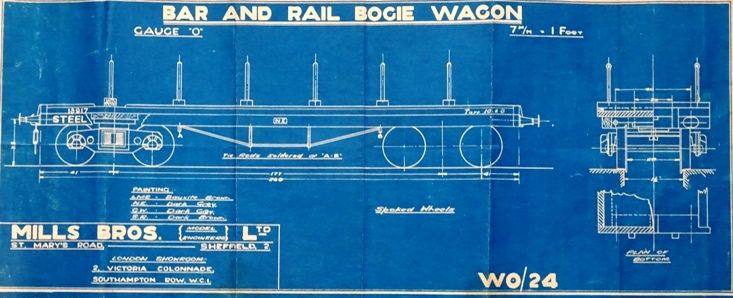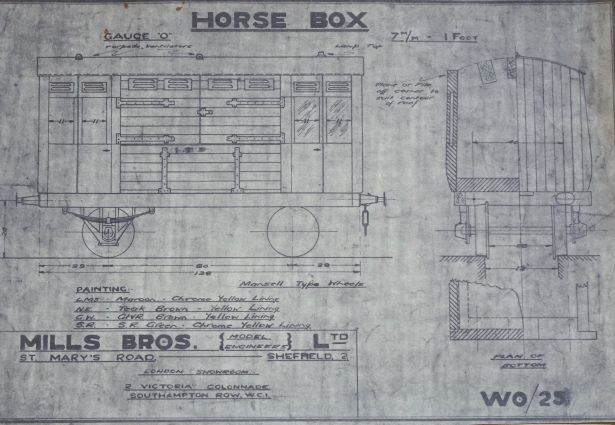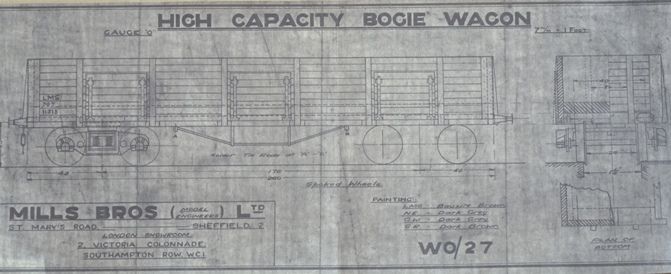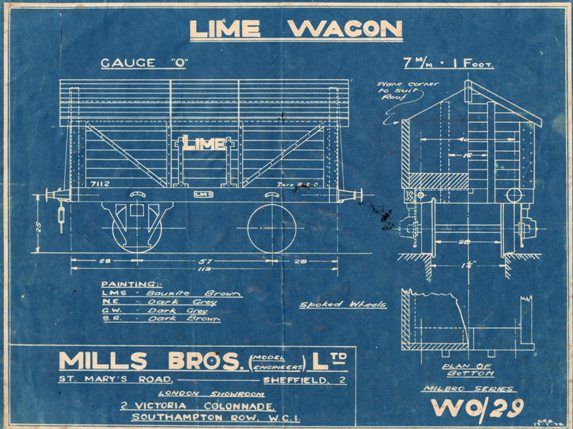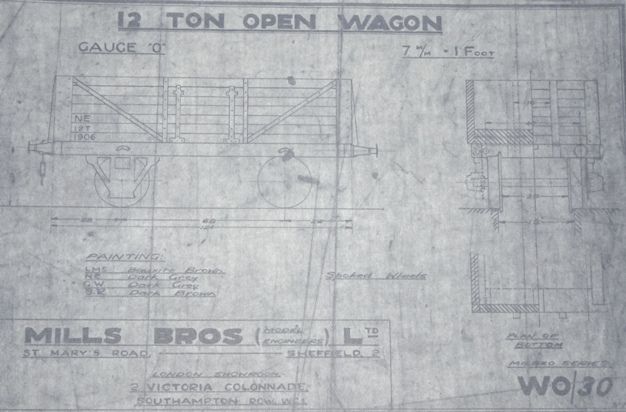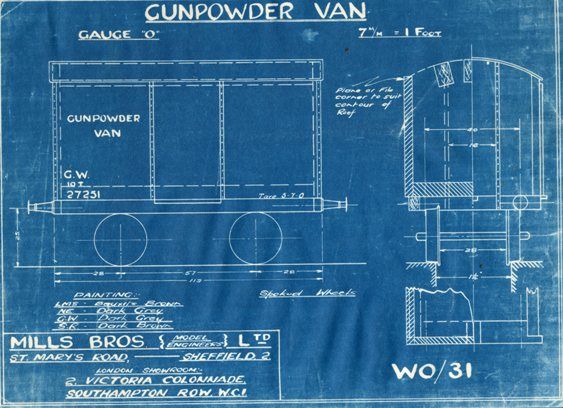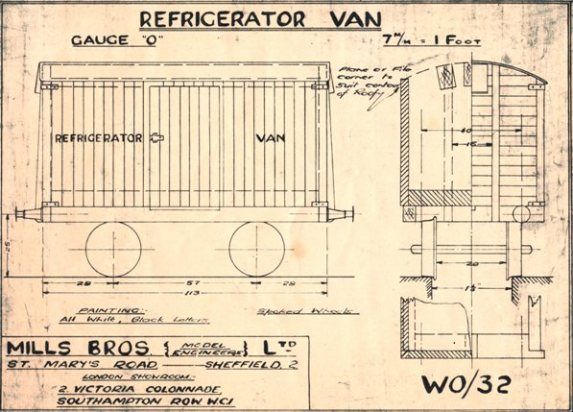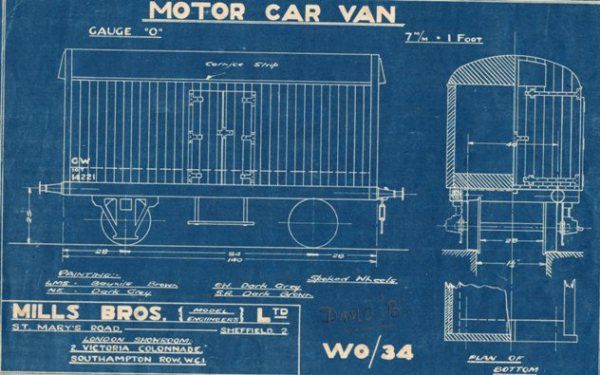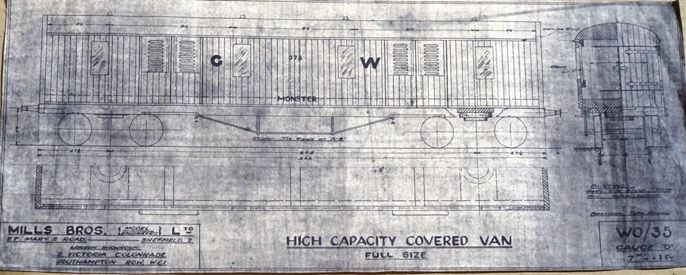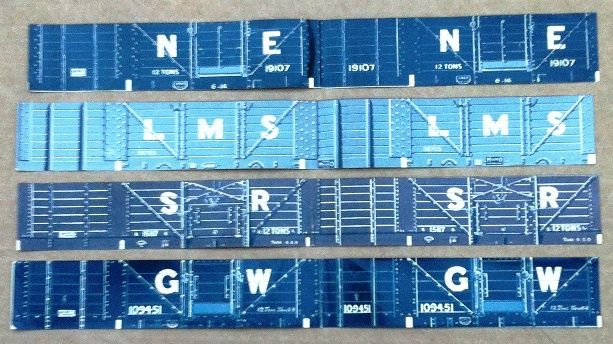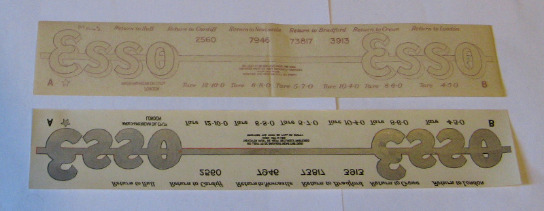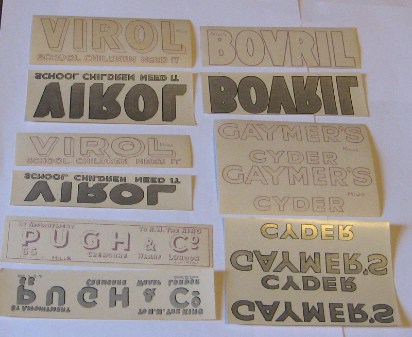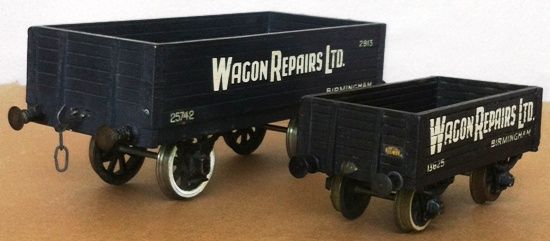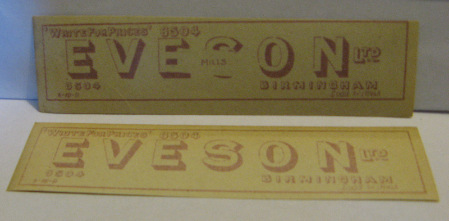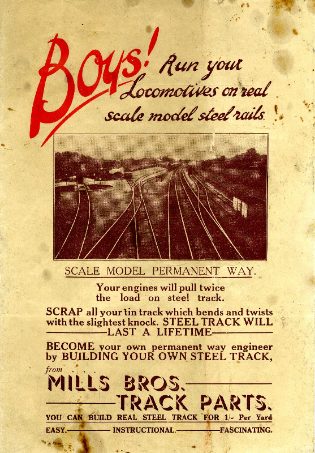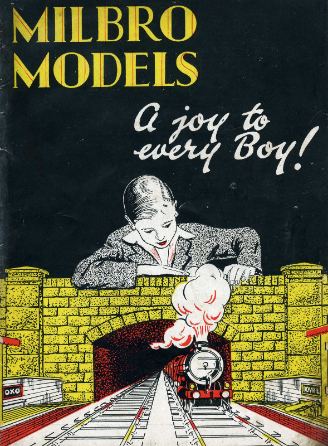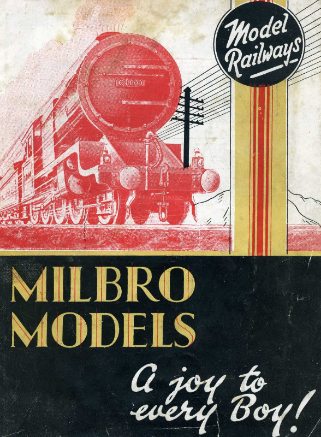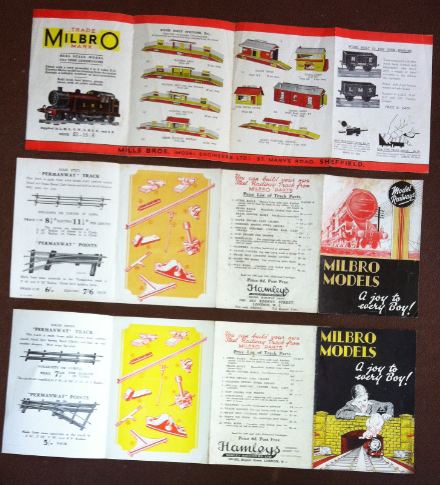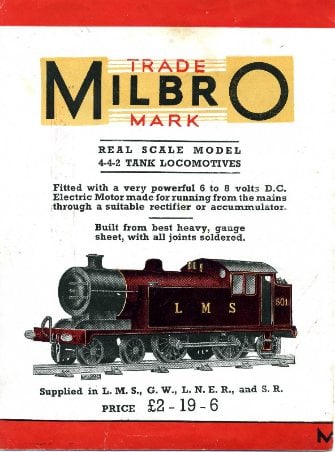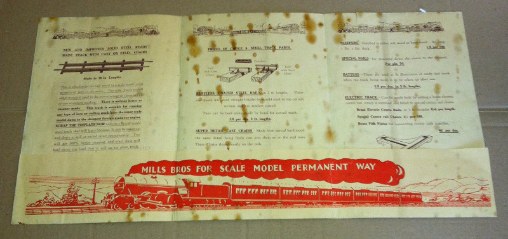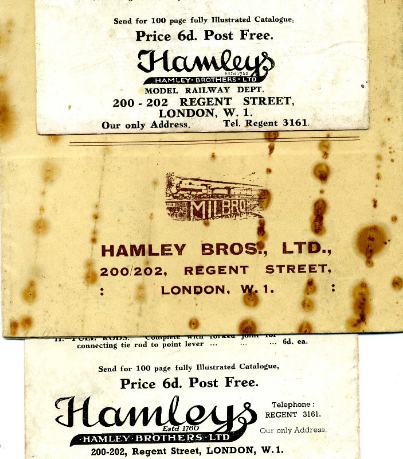
Milbro Artwork * The material in this section has been added to most recently in March 2025 *
Milbro Artwork, illustrations and drawings
Copyright is retained by M.L.Harrison for all text and photos, except for those taken by other owners and enthusiasts.
M.L.Harrison 2020, 2025 © All rights reserved.
This section presents selected illustrations of Mills documents, products, packaging and advertising.
Correspondence, letter-heads, invoices, general packaging, boxes, trade marks, etc. As with many railway models firms, Milbro used railway scenes or images on some of their documentation and packaging. Two of the letter-head designs that did this are shown below in Illustrations A1a and A1b. These date from August 1941 and January 1939. The 1941 letter (the first below) regrets that the firm cannot proceed with the manufacture of some goods to meet the balance of an order, as " ... all our staff are engaged on work of national importance and we are finding it extremely difficult to release anyone just now for model work."
Illustrations A1a and A1b To show two of the Milbro letter-heads. These designs and the letters they were on were of similar width, although my scans do not make that clear.
The brown packets included at the right on Illustration A2 are typical of the small envelopes (of varying sizes) frequently used by Milbro when supplying fittings, pins and track or rolling stock parts, and also for relatively unusual items such as glass panes for coaches. Illustration A3 contains another envelope of this type, with a standard Mills railway drawing included upon it. Small cardboard boxes for parts are also found occasionally, and an example of a decorated one is shown in Illustration A4 below. Illustration A2 A plainer letter-head from 1956, together with examples of other documents, and two of the small brown packets/envelopes used when selling parts, etc.
Illustration A3 Another picture of one of the firm's packets. The image of the loco shown near the top was frequently deployed by Milbro.
Illustration A4 A small box containing parts. My guess is that this might perhaps be of later date than the envelopes above.
Complete model railway items such as wagons or buffer stops were often also sold in cardboard boxes. The Mills ones I have seen have been plain, and often carried fairly small yellow company labels. These labels generally had space for the insertion of details, and descriptions were often written on by the company in pencil. The entry on the first example below, however, is in ink. In this case there is also a coloured sticker to indicate the livery. Glued-on brown paper strip has been used to reinforce or join things up. Sadly, a large majority of wagons and accessories today turn up without their original boxes, so it is difficult to be sure about possible variations in box design or labelling, but a cardboard wagon box may open either at its end or have a separate top that lifts off. The second picture below shows two wagon boxes with unusual white labels. The box lids look as if they might have been coloured, although they have deteriorated over time. I do not have any labelled examples at all at present of the packaging used for Milbro locomotives.
Illustration A5a A fairly representative example of the Milbro cardboard wagon boxes that occasionally turn up today. Similar ones were used for other items such as buffer stops.
Illustration A5b. Two wagon boxes with unusual white labels. This might conceivably be the result of the fading away of original yellow colouring, but looks more like a varaint in what the firm provided.
Illustration A5c Milbro tape, in this case used to secure the lid of a box containing wooden sleepers. It is surprising that the tape has survived, as it is now fairly fragile.
One of the two types of standard gold trade mark transfers added to wagons and coaches is shown in our section on wagons, and is followed there by a picture of an earlier version with different colouring. Other markings might also be found occasionally (as with the trade mark shown on a building in our section on other items). The one below is on a model tractor made in the 1940s, and features the title 'Mills Model' rather than 'Milbro'. I am very grateful to the owner of this vehicle, who sent me several photographs, and authoritatively explained the relevant history. See the section on Mills Locomotives and the Introduction section for further images and comment.
Illustrations A6a and A6b A rare example of a trade mark for a Sheffield 'Mills Model', and the special wooden box in which this item was supplied. See Introduction and Locomotives sections for pictures of the tractor that came in this box.
Other product labelling Milbro produced a variety of things to be used by modellers, and the tins for paints and similar substances were obvious places to put the company name. Most Mills tins will have been lost or destroyed long ago, but I am able to show a couple of survivors below, in Illustration A7. Unfortunately, when past owners used these two tins, the contents unsurprisingly found their way onto the paper labels. Even so, readers will be able to see the styles the firm used. Some years ago I experimented with using the old Milbro LMS grey paint for restoring a wooden Mills wagon, and it was still viable, although much brighter and lighter than I had expected. Illustration A7 Milbro tins, one for red oxide and one for grey paint.
'Functional artwork'; drawings, lithos and transfers for enthusiasts and other firms to use Milbro was one of the suppliers of the technical drawings or plans that could be used when someone was building rolling stock, trackwork, etc. Numerous transfers were also offered for fixing onto wagons, coaches or locomotives. Although all these products primarily served practical purposes for modellers, it seems reasonable to view them also today as part of the historical record of the company's artwork. Two examples of the plans available for wagons are included in the section on Mills wagons elsewhere on this site, and we show more below from the ranges. First, to complement those illustrations, the picture below gives an idea of what was available to assist the building of trackwork. Coincidentally, the radius for the track shown in one of these drawings is 4 feet 9 inches, the recommended radius for the first large catalogued Milbro locomotive, the 'Hush-Hush' (see the section of this site on locomotives made by Mills Bros.).
Illustration A8a. Examples of trackwork diagrams. This photo has not come out very well, but I hope the general style and character can be seen. The drawings were made full-size by the company in relation to the track and components being delineated.
Wagon drawings Almost all the individual drawings shown below are for 0 gauge, and match closely the models as catalogued by the company. I also show a single example from what would have been an earlier 0 gauge range, with what seems to be Greenly's signature, and one similar item for Gauge One. Thanks to Bob Burgess for helping me secure the drawings from a specific collection which provided the majority of those reproduced below. It can be noted that these drawings could prove useful for wagon identification where someone needs to check construction details on a standard wagon from the later periods of pre-war Milbro production. There may be one or two variations, where an authentic wooden wagon does not necessarily quite match the drawing, but perhaps not many. (One instance might be with a small detail on the boiler wagon.) An additional point is that it should be possible for someone with the appropriate skills to build an accurate version of one of the scarcer Milbro wagons below, if desired !
Illustrations A8b and A8c. Catalogue pages showing the range of wagon drawings on offer (although one or two drawings are not included but were available with specific kits, and WO 35 has not been added). I have not so far seen any of the coach blueprints. The catalogues are from 1941 (or thereabouts) and 1956-57.
Some of the drawings reproduced below are white photocopies or prints made from the original factory blue versions. Unfortunately, not all these white copies have survived in good condition, so the quality of what we show varies considerably. Luckily, only one of blueprints (W0/1) has been damaged significantly ! NB. Our images do not reproduce the originals in a way that directly reflects their relative size.
Illustrations A8di-A8dxxvii. Some of the wagon drawings available from Milbro. Those labelled MB 006 and MB111 seem to be from an earlier series and carry what may be Greenly's signature. NB. It is not always the case that a factory-made wagon matches exactly with the drawing. For example, a vehicle may have extra detail.
Lithographed wagon papers Four open wagons were sold by the company with 'wrap around' paper artwork fixed onto them. They were described as having wooden bodies together with lithographed paper sides and ends, and were similar in character to items produced by the Leeds Model Company. The papers were also available separately, and quite large numbers have survived. The Milbro wagons were described in our section about wooden wagons, but it seems worth also showing the papers now as parts of the firm's design work.
Illustration A9. Papers available for fixing to wagon sides and ends. These are quite shiny, and have caught the light a little too much in this picture. Their actual size is a little under 36mm long.
Transfers Amongst the many transfers produced by Mills, the private owner wagon ones are generally the most striking. Transfers were produced for the sides of private owner box vans and open wagons, and for ESSO, PRATTS and ROYAL DAYLIGHT spirit or oil wagons. They were applied to the company's models, and also sold (as pairs) for customers to put on their own rolling stock. Significant numbers of private owner transfers must have been produced, as examples have turned up quite frequently (although some seem rarer than others, and there may be one or two I have not encountered). I also do not possess any examples of these transfers for larger scales, so all illustrations below are for Gauge 0. The front face of unused transfers is often a little faded and dull-looking, but the underside can look more impressive, where silver may be visible along with occasional hints of the colours that will be seen when the transfer has been applied. Some earlier transfers, however, do not have anything visible from the front, and the backs look very plain (see below, PRATTS bogie wagon transfer, etc.).
Illustration A10. A pair of one of the bogie spirit wagon transfers made by Mills. One is seen from the front and the other from the back. See the Wagons section of this website for a photo of an ESSO bogie spirit wagon.
(The actual length of the transfer here is around 11 inches, including the decorative line that runs through the letters and would have extended close to each end of the vehicle body.)
Illustrations A10a and A10b. Transfers that seem to have been made for the earlier bogie Esso wagon type that was offered by Milbro, and can be seen in the 1935-1936 catalogue. These seem to have been made without any tare numbers or other notices being included alongside the ESSO letters, but perhaps there may have been something provided on a separate transfer sheet. The sheets above are marked clearly as Mills products. The wagons as advertised had fairly large A and B letters towards the body ends, as well as other small lettering below, but there are no signs of our examples having had anything cut off. On the other hand that remains an alternative possibility alongside the likelihood of an accompanying sheet. We show the Pratts version at Illustration A12 below.
Illustration A10c. Some more transfers seen from front and back; VIROL (box van and open wagon versions), BOVRIL (box van), GAYMER'S CYDER (box van), and PUGH & Co (open wagon). I don't think I've got any Mills catalogue or advertisement picture of a wagon with the Pugh transfer.
Illustrations A10d-A10f. More of the wagon transfers. All these are for 0 Gauge, but I have not standardised their representation in terms of size across the four photos (so some look relatively bigger or smaller than they actually are). In practice they were all designed to fit standard 4-wheel vehicles of the box van, open wagon or spirit wagon types. The 4-wheel Esso spirit and oil wagon transfers in Illustration A10e include a version at the top that I assume was designed at the time of the 1935-1936 catalogue, but the positioning of the smaller lettering differs from that on the vehicle as catalogued. Of course these elements could be placed wherever was chosen when applied. Illustration A10g. This is another Mills version of the Esso 4-wheel spirit vehicle transfer, for fixing on a black oil wagon. It is very plain, but the yellow colour for the lettering can be seen. This sheet's actual size is roughly four and three-quarter inches by one and three-quarters.
Illustrations A11b and A11c All my examples of 'private owner' wagon transfers are from the range available for 0 gauge, and at present I do not have any I can show from those made by Milbro for larger rolling stock. These two photos include a Mills Gauge 1 wagon that was given transfers made for 0 gauge when it was repainted, but it does at least give an idea of the size of the transfer sheets that would have been needed in the larger scale. (For another picture of these two wagons see the Wagons section.) I am not sure that this specific PO livery was supplied in the larger size, so this Gauge 1 wagon may well look like what Milbro would have sold in response to a request for this livery on a G1 vehicle.
Illustration A12. The transfer for the PRATTS bogie spirit wagon. This seems a relatively scarce item. I do not think I have seen the smaller transfer sheet that was made for the 4-wheel Pratt's Spirit Wagon, although the actual 4-wheel wagons have turned up from time to time (see immediately below). The Pratts bogie and 4-wheel spirit wagons were catalogued along with a Royal Daylight 4-wheel oil wagon around 1933-1935.
Illustration A12a. This shows what the transfers for the 4-wheel version were like. It seems that at some time in the past large areas of grey paint on this particular wagon were perhaps 'refreshed' very carefully by an owner, presumably because they had deteriorated or faded. The model was enhanced slightly (probably at the same time), as can be seen with the wires. My photo has made the bodywork look just a little lighter grey than it actually is. The transfers seem to have been preserved well, including a Milbro logo.
It should be noted that the half-a-dozen different specific transfer sets for 4-wheel oil or spirit wagons would normally be expected to have been placed on wagons of particular colours. Nonetheless, a vehicle can turn up with unexpected paintwork. While this may usually indicate a kit or a repaint, I think the firm would have been likely to supply a specific livery if requested. I'm not sure whether the factory usually used a cream body or a grey one as 'standard' to carry the particular set of transfers seen on the example below, but it may well have supplied both. Illustration A12b. I do not know whether the set of transfers seen here would have been applied more usually on a grey wagon body or a cream one like this, but I have seen too few examples to be confident about that. This wagon has been heavily restored over the years, but more needs doing to tidy it up (although the photo makes the paint look more discoloured than it actually is). We show the wagon also in our page on Mills wagons.
Some transfers carry the word 'MILLS' on the front, which clearly helps as an identifier. The company do not seem to have been very consistent with this, as can be seen from the pair of EVESON transfers shown in the next illustration.
Illustration A13. Two EVESON transfers.
Apart from its private owner transfers the firm made quite a wide array of standard labels of various kinds. Many are very familiar to Milbro collectors, but some seem a little less common. I have only ever encountered one Mills factory-built wagon with the firm's 'Loco Coal Only' labels. This had been restored before I got it but the lettering was in a poor state and more or less entirely gone on one side. Recently (2025) I used Mills transfers to replace these labels, and this was eventually reasonably successful. However, some old Milbro transfers may disintegrate when put into use, and this was a problem that made the job very awkward. When transfers fail it may mean the loss of something very scarce! We show these rare transfers below on the wagon. The second image is of a Banana Van label, along with the remains of a 'Midland' one, on the side of a standard early van. Most of these white vans seem to be labelled as refrigerator vehicles rather than Banana Vans, and this is the only example I have had of the Banana version. The vehicle has been restored, as quite a lot of woodwork had been lost before I got it.
Illustration A13a. Examples of some of the wagon label transfers that do not seem to appear very often on Mills factory-made wagons. These two wagons may be seen more fully elsewhere in other Milbro pages of this site. The open wagon's colour is actually a very dark brown.
Direct advertising The Home Page on this site features the cover of a Milbro advertising brochure, and the Introduction section includes a picture of catalogue covers. Some further scans and photographs are included now of three versions of brochures (including the one on the Home Page). I think there is at least one more of these brochures that I do not have, although I have seen it briefly.
Illustration A14. Cover/front page of a brochure with six panels and a folding-in strip along the base. Actual page size is about 153mm by 223mm.
Illustration A15 The brochure cover/front page shown on our Home Page. This brochure has eight panels. Actual page size is about 125mm by 174mm.
Illustration A16 The cover/front page of another brochure with eight panels. Actual page size is about 125mm by 170mm. Illustration A17 Three pictures of unfolded Milbro brochures. The top two are the same brochure as each other, but seen from reverse sides. Illustration A18 One of the panels, showing a standard tank model.
Illustrations A19a and A19b The first brochure shown above, now seen from both sides. The red drawing of a train folds in. The paper has been damaged, perhaps by grease, oil or rust, but the item is a rare one. These two photographs make the paper look less brown that it actually is ! Illustration A20 All the three brochures shown above carry the retailer Hamleys name at the foot of the back panel.
|
